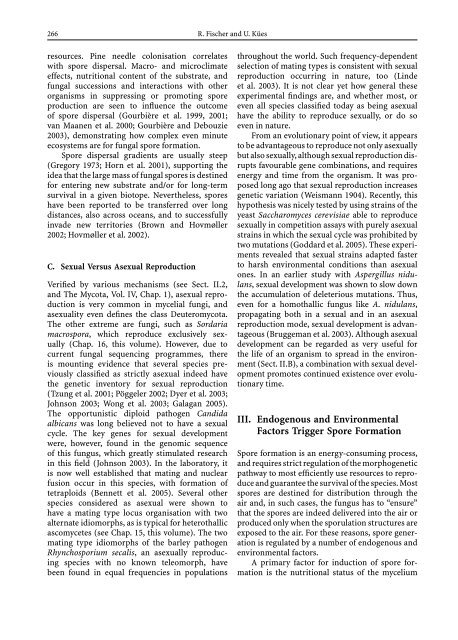Growth, Differentiation and Sexuality
Growth, Differentiation and Sexuality
Growth, Differentiation and Sexuality
Create successful ePaper yourself
Turn your PDF publications into a flip-book with our unique Google optimized e-Paper software.
266 R. Fischer <strong>and</strong> U. Kües<br />
resources. Pine needle colonisation correlates<br />
with spore dispersal. Macro- <strong>and</strong> microclimate<br />
effects, nutritional content of the substrate, <strong>and</strong><br />
fungal successions <strong>and</strong> interactions with other<br />
organisms in suppressing or promoting spore<br />
production are seen to influence the outcome<br />
of spore dispersal (Gourbière et al. 1999, 2001;<br />
van Maanen et al. 2000; Gourbière <strong>and</strong> Debouzie<br />
2003), demonstrating how complex even minute<br />
ecosystems are for fungal spore formation.<br />
Spore dispersal gradients are usually steep<br />
(Gregory 1973; Horn et al. 2001), supporting the<br />
idea that the large mass of fungal spores is destined<br />
for entering new substrate <strong>and</strong>/or for long-term<br />
survival in a given biotope. Nevertheless, spores<br />
have been reported to be transferred over long<br />
distances, also across oceans, <strong>and</strong> to successfully<br />
invade new territories (Brown <strong>and</strong> Hovmøller<br />
2002; Hovmøller et al. 2002).<br />
C. Sexual Versus Asexual Reproduction<br />
Verified by various mechanisms (see Sect. II.2,<br />
<strong>and</strong> The Mycota, Vol. IV, Chap. 1), asexual reproduction<br />
is very common in mycelial fungi, <strong>and</strong><br />
asexuality even defines the class Deuteromycota.<br />
The other extreme are fungi, such as Sordaria<br />
macrospora, which reproduce exclusively sexually<br />
(Chap. 16, this volume). However, due to<br />
current fungal sequencing programmes, there<br />
is mounting evidence that several species previously<br />
classified as strictly asexual indeed have<br />
the genetic inventory for sexual reproduction<br />
(Tzung et al. 2001; Pöggeler 2002; Dyer et al. 2003;<br />
Johnson 2003; Wong et al. 2003; Galagan 2005).<br />
The opportunistic diploid pathogen C<strong>and</strong>ida<br />
albicans was long believed not to have a sexual<br />
cycle. The key genes for sexual development<br />
were, however, found in the genomic sequence<br />
of this fungus, which greatly stimulated research<br />
in this field (Johnson 2003). In the laboratory, it<br />
is now well established that mating <strong>and</strong> nuclear<br />
fusion occur in this species, with formation of<br />
tetraploids (Bennett et al. 2005). Several other<br />
species considered as asexual were shown to<br />
have a mating type locus organisation with two<br />
alternate idiomorphs, as is typical for heterothallic<br />
ascomycetes (see Chap. 15, this volume). The two<br />
mating type idiomorphs of the barley pathogen<br />
Rhynchosporium secalis, anasexuallyreproducing<br />
species with no known teleomorph, have<br />
been found in equal frequencies in populations<br />
throughout the world. Such frequency-dependent<br />
selection of mating types is consistent with sexual<br />
reproduction occurring in nature, too (Linde<br />
et al. 2003). It is not clear yet how general these<br />
experimental findings are, <strong>and</strong> whether most, or<br />
even all species classified today as being asexual<br />
have the ability to reproduce sexually, or do so<br />
even in nature.<br />
From an evolutionary point of view, it appears<br />
to be advantageous to reproduce not only asexually<br />
but also sexually, although sexual reproduction disrupts<br />
favourable gene combinations, <strong>and</strong> requires<br />
energy <strong>and</strong> time from the organism. It was proposed<br />
long ago that sexual reproduction increases<br />
genetic variation (Weismann 1904). Recently, this<br />
hypothesis was nicely tested by using strains of the<br />
yeast Saccharomyces cerevisiae able to reproduce<br />
sexually in competition assays with purely asexual<br />
strains in which the sexual cycle was prohibited by<br />
two mutations (Goddard et al. 2005). These experiments<br />
revealed that sexual strains adapted faster<br />
to harsh environmental conditions than asexual<br />
ones. In an earlier study with Aspergillus nidulans,<br />
sexual development was shown to slow down<br />
the accumulation of deleterious mutations. Thus,<br />
even for a homothallic fungus like A. nidulans,<br />
propagating both in a sexual <strong>and</strong> in an asexual<br />
reproduction mode, sexual development is advantageous<br />
(Bruggeman et al. 2003). Although asexual<br />
development can be regarded as very useful for<br />
thelifeofanorganismtospreadintheenvironment<br />
(Sect. II.B), a combination with sexual development<br />
promotes continued existence over evolutionary<br />
time.<br />
III. Endogenous <strong>and</strong> Environmental<br />
Factors Trigger Spore Formation<br />
Spore formation is an energy-consuming process,<br />
<strong>and</strong> requires strict regulation of the morphogenetic<br />
pathway to most efficiently use resources to reproduce<br />
<strong>and</strong> guarantee the survival of the species. Most<br />
spores are destined for distribution through the<br />
air <strong>and</strong>, in such cases, the fungus has to “ensure”<br />
that the spores are indeed delivered into the air or<br />
produced only when the sporulation structures are<br />
exposed to the air. For these reasons, spore generation<br />
is regulated by a number of endogenous <strong>and</strong><br />
environmental factors.<br />
A primary factor for induction of spore formation<br />
is the nutritional status of the mycelium

















